
- Jantar Mantar
It consists of 13 architectural astronomy instruments which can be used to compile the astronomical tables and to predict the movement and timings of the sun, moon and planets. The site is one of five such observatories located in Jaipur, Ujjain, Varanasi and Mathura built by Maharaja Jai Singh II of Jaipur, from 1723 onwards, as he was given by Mughal emperor Muhammad Shah the task of revising the calendar and astronomical tables.
The apparatus here pertains to Egypt's Ptolemaic astronomy and follows three classical celestial coordinates to track the positions of heavenly bodies- namely horizon-zenith local system, the equatorial system and the ecliptic system. There are four primary devices constructed here: The Samrat Yantra, the Jai Prakash, Ram Yantra and Misra Yantra.

- Connaught Place
Connaught Place has imparted as much character and experiences to the list of places to visit in Delhi and its residents as has the Parliament or the Red Fort. It is a historical structure, a shopper’s haven, a foodie’s delight, a culture buff’s destination. The truth is, Connaught Place, or CP as it is universally known, offers many unique experiences all rolled into one.
The mammoth circular ivory white structure was built by the British in 1929 as part of their project to relocate the seat of governance from Civil Lines to Lutyen’s Delhi. The market has been named after the first Duke of Connaught but was later renamed after the Gandhis during the time of Union Home Minister S.B. Chavan (Inner circle was rechristened Rajiv Chowk and the outer circle was called Indira Chowk). Today, this is the fourth most expensive office destination in the world and the fifth highest priced market in the world as per some consultancy firms.
There are several shops, restaurants, offices and it’s a lively part of the city where many people head to especially for the weekends. There are also markets nearby for almost everything you can think of. If you want to check out food in Delhi there are also food tours you can join.
- India Gate and Canopy
At the centre of New Delhi stands the 42 m high India Gate, an "Arc-de-Triomphe" like archway in the middle of a crossroad. Almost similar to its French counterpart, it commemorates the 70,000 Indian soldiers who lost their lives fighting for the British Army during the World War I. The memorial bears the names of more than 13,516 British and Indian soldiers killed in the Northwestern Frontier in the Afghan war of 1919.
The foundation stone of India Gate was laid by His Royal Highness, the Duke of Connaught in 1921 and it was designed by Edwin Lutyens. The monument was dedicated to the nation 10 years later by the then Viceroy, Lord Irwin. Another memorial, Amar Jawan Jyoti was added much later, after India got its independence. The eternal flame burns day and night under the arch to remind the nation of soldiers who laid down their lives in the Indo-Pakistan War of December 1971.
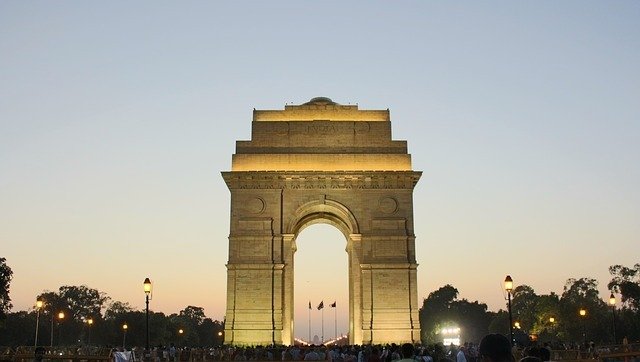
The entire arch stands on a low base of red Bharatpur stone and rises in stages to a huge moulding. The cornice is inscribed with the Imperial suns while both sides of the arch have INDIA, flanked by the dates MCMXIV (1914 left) and MCMXIX (1919 right). The shallow domed bowl at the top was intended to be filled with burning oil on anniversaries but this is rarely done.
During nightfall, India Gate is dramatically floodlit while the fountains nearby make a lovely display with coloured lights. India Gate stands at one end of Rajpath, and the area surrounding it is generally referred to as 'India Gate'.
Surrounding the imposing structure is a large expanse of lush green lawns, which is a popular picnic spot. One can see hoards of people moving about the brightly lit area and on the lawns on summer evenings.
- The Red Fort (Lal Qila)
The Red sandstone walls of the massive Red Fort (Lal Qila) rise 33-m above the clamour of Old Delhi as a reminder of the magnificent power and pomp of the Mughal emperors. The walls, built in 1638, were designed to keep out invaders, now they mainly keep out the noise and confusion of the city. The private apartments consist of a row of pavilions connected by a continuous water channel, known as the Nahr-i-Behisht (Stream of Paradise). The Red Fort is considered to represent the zenith of Mughal creativity which, under the Shah Jahan, was brought to a new level of refinement. The planning of the palace is based on Islamic prototypes, but each pavilion reveals architectural elements typical of Mughal building, reflecting a fusion of Persian, Timurid and Hindu traditions The Red Fort’s innovative planning and architectural style, including the garden design, strongly influenced later buildings and gardens in Rajasthan, Delhi and Agra.
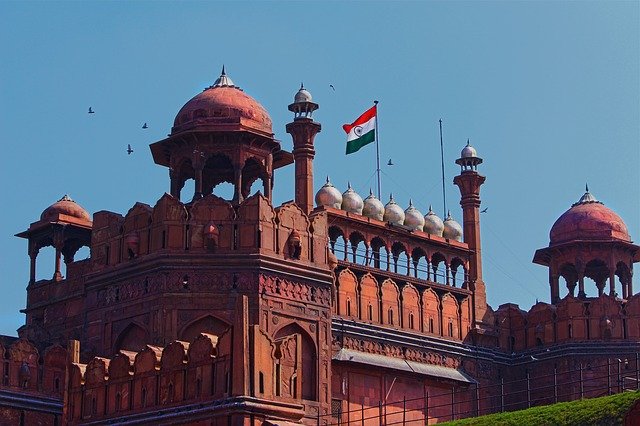
The main gate, Lahore Gate, is one of the emotional and symbolic focal points of the modern Indian nation and attracts a major crowd on each Independence Day.
The vaulted arcade of Chatta Chowk, a bazaar selling tourist trinkets, leads into the huge fort compound. Inside is a veritable treasure trove of buildings, including the Drum House, the Hall of Public Audiences, the white marble Hall of Private Audiences, the Pearl Mosque, Royal Baths and Palace of Color.
An evening sound and light show re-creates events in India's history connected with the fort.
- Qutub Minor
This is a 120-meter minaret. It’s the world’s tallest brick minaret. Amazing that you can still see this considering it was built by Qutub-ud-Din Aibak in 1192. Yes, 1192, the tower was built to celebrate Muslim dominance in Delhi after the defeat of Delhi’s last Hindu ruler. It’s also the highest tower in India, complete with 5 storeys and projecting balconies. Apart from the tower, within the complex, you will also find Quwwat-us-Islam Mosque, the first mosque to be built in India.
The Qutub Minar is a minaret that forms a part of the Qutab complex, a UNESCO World Heritage Site in the Mehrauli area of Delhi, India. Qutub Minar is a 73-metre (239.5 feet) tall tapering tower of five storeys, with a 14.3 metres (47 feet) base diameter, reducing to 2.7 metres (9 feet) at the top of the peak. It contains a spiral staircase of 379 steps. Its design is thought to have been based on the Minaret of Jam, in western Afghanistan.
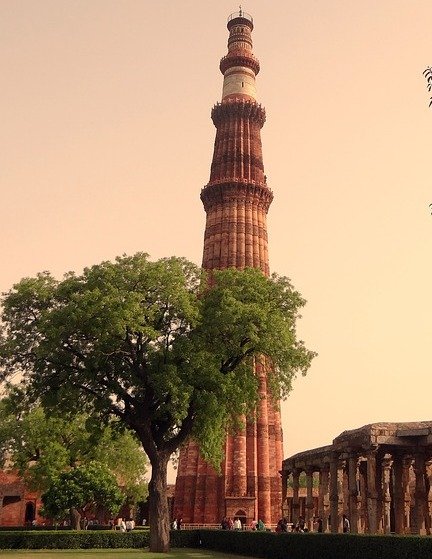
Qutab-Ud-Din-Aibak, founder of the Delhi Sultanate, started construction of the Qutub Minar's first storey around 1192. In 1220, Aibak's successor and son-in-law Iltutmish completed a further three storeys. In 1369, a lightning strike destroyed the top storey. Firoz Shah Tughlaq replaced the damaged storey, and added one more. Sher Shah Suri also added an entrance to this tower while he was ruling and Humayun was in exile.
The Minar is surrounded by several historically significant monuments of the Qutab complex, including Quwat-ul-Islam Mosque, which was built at the same time as the Minar, and the much older Iron Pillar of Delhi. The nearby pillared Cupola known as "Smith's Folly" is a remnant of the tower's 19th century restoration, which included an ill-advised attempt to add a sixth storey.
- Humayun’s Tomb
One of our absolute favourite places in Delhi. Humayun’s Tomb is one of the most magnificent tombs built during Mughal’s rule. Inspired by Persian architecture.
Humayun’s Tomb, Delhi is the first of the grand dynastic mausoleums that were to become synonyms of Mughal architecture with the architectural style reaching its zenith 80 years later at the later Taj Mahal. Humayun’s Tomb stands within a complex of 27.04 ha. that includes other contemporary, 16th century Mughal garden-tombs such as Nila Gumbad, Isa Khan, Bu Halima, Afsarwala, Barber’s Tomb and the complex where the craftsmen employed for the Building of Humayun’s Tomb stayed, the Arab Serai.
Humayun’s Tomb was built in the 1560’s, with the patronage of Humayun’s son, the great Emperor Akbar. Persian and Indian craftsmen worked together to build the garden-tomb, far grander than any tomb built before in the Islamic world. Humayun’s garden-tomb is an example of the charbagh (a four quadrant garden with the four rivers of Quranic paradise represented), with pools joined by channels. The garden is entered from lofty gateways on the south and from the west with pavilions located in the centre of the eastern and northern walls.
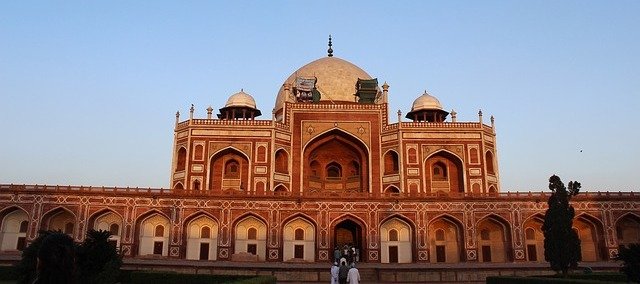
The mausoleum itself stands on a high, wide terraced platform with two bay deep vaulted cells on all four sides. It has an irregular octagon plan with four long sides and chamfered edges. It is surmounted by a 42.5 m high double dome clad with marble flanked by pillared kiosks (chhatris) and the domes of the central chhatris are adorned with glazed ceramic tiles. The middle of each side is deeply recessed by large arched vaults with a series of smaller ones set into the facade.
The interior is a large octagonal chamber with vaulted roof compartments interconnected by galleries or corridors. This octagonal plan is repeated on the second storey. The structure is of dressed stone clad in red sandstone with white and black inlaid marble borders.
Humayun’s garden-tomb is also called the ‘dormitory of the Mughals’ as in the cells are buried over 150 Mughal family members.
The tomb stands in an extremely significant archaeological setting, centred at the Shrine of the 14th century Sufi Saint, Hazrat Nizamuddin Auliya. Since it is considered auspicious to be buried near a saint’s grave, seven centuries of tomb building has led to the area becoming the densest ensemble of medieval Islamic buildings in India.
- The Lotus Temple (Bahai House of Worship)
The Lotus Temple, located in Delhi, India, is a Bahá'í House of Worship that was dedicated in December 1986, costing $10 million. Notable for its flowerlike shape, it has become a prominent attraction in the city. Like all Bahá'í Houses of Worship, the Lotus Temple is open to all, regardless of religion or any other qualification. The building is composed of 27 free-standing marble-clad "petals" arranged in clusters of three to form nine sides, with nine doors opening onto a central hall with a height of slightly over 40 metres and a capacity of 2,500 people. The Lotus Temple has won numerous architectural awards and has been featured in many newspaper and magazine articles. A 2001 CNN report referred to it as the most visited building in the world.
Since its inauguration to public worship and visits in December 1986, the Bahá’í House of Worship in New Delhi, India has drawn to its portals more than 70 million visitors, making it one of the most visited edifices in the world. On an average, 8,000 to 10,000 people visit the Bahá’í House of Worship each day. These visitors have admired its universal design in the form of a lotus and have been fascinated by the Teachings of the Bahá’í Faith, especially its tenets of the Oneness of God, the Oneness of Religions, and the Oneness of Mankind.
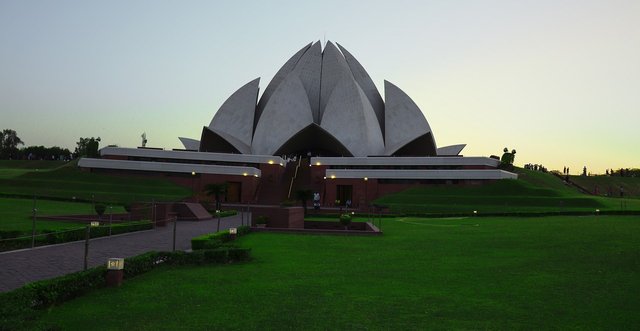
Visitors are welcome inside. No photography is allowed inside. It’s open 9.30-5.30 and until 7pm in the summer. Entry is Free. Also, note that shoes are not allowed so prepare for the hot ground when the sun is in full force.
- Akshar Dham Temple
Swaminarayan Akshardham in New Delhi epitomizes 10,000 years of Indian culture in all its breathtaking grandeur, beauty, wisdom an d bliss. It brilliantly showcases the essence of India’s ancient architecture, traditions and timeless spiritual messages. The Akshardham experience is an enlightening journey through India’s glorious art, values and contributions for the progress, happiness and harmony of mankind.
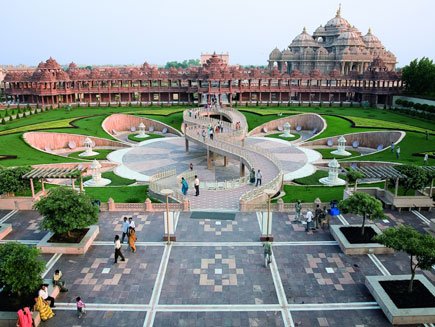
The Swaminarayan Akshardham complex was built in only five years through the blessings of HDH Pramukh Swami Maharaj of the Bochasanwasi Shri Akshar Purushottam Swaminarayan Sanstha (BAPS) and the colossal devotional efforts of 11,000 artisans and thousands of BAPS volunteers. Heralded by the Guinness World Record as the World’s Largest Comprehensive Hindu Temple, the complex was inaugurated on 6 November, 2005.
What to Experience
Akshardham Mandir
A traditional mandir (temple) dedicated to Bhagwan Swaminarayan that reflects the beauty and spirituality of India’s ancient art, culture, and architecture
Nilkanth Varni Abhishek
A hallowed spiritual tradition in which prayers are offered for world peace and continual peace for oneself, family, and friends with the water of 151 holy rivers, lakes and ponds of India.
Exhibitions
Hall 1 - Hall of Values (50 mins)
Experience enduring human values through films and robotic shows that depict the ideals of nonviolence, honesty, family harmony, and spirituality.
Hall 2 - Giant Screen Film (40 mins)
Discover India through the incredible story of an eleven-year-old yogi named Nilkanth that brings to life the culture and spirituality of India's customs, the majesty of its art and architecture, and the unforgettable sights, sounds, and power of its awe-inspiring festivals.
Hall 3 - Cultural Boat Ride (15 mins)
Sail through 10,000 years of India's glorious heritage. Learn about the discoveries and inventions of the rishi-scientists of India, see the world’s first university of Takshashila, sail through the caves of Ajanta-Ellora and discover India's contributions to humanity through the ages.
Timings: First Entry: 9:30 AM
Last Entry: 6:30 PM
Exhibition Tickets: 10 AM to 5PM
Complex Entry: Free | No Ticket
Exhibition: Fee | Ticket
Adults : 170
Senior Citizen : 125
Child (4-11 yrs) : 100
Child (Below 4 yrs) : Free
Musical Fountain: Fee | Ticket
Adults: 30
Senior Citizen : 30
Child (4-11 yrs) : 20
Child (Below 4 yrs) : Free
Day Closed: Mondays
Photography: Not allowed
Mobiles & Electronics: Not allowed (Cloakroom Available)
- Jama Masjid
The Masjid-i jahan-numah or the Jama Masjid acquires a position in one of the biggest mosques in India. It is not surprising that it is crowded with visitors every now and then making it one of the most visited shrines too. This magnificent building is standing proud and tall even after many ups and downs. It has quite a history to tell. Let’s begin our journey towards the World Reflecting Mosque, as it is popularly known.
Jama Masjid was built by Shah Jahan between 1644-1656 at a cost of 1 million rupees. It was constructed by more than 5,000 workers which is quite a normal deal to make a huge structure. The mosque was inaugrated by an imam from Bukhara (the present day Uzbekistan). The Largest Masjid, because.. a whooping amount of 25,000 people can pray in the courtyard of the mosque at the same time. Not just the courtyard, but the mosque in whole can handle 85,000 people at once! That’s a LOT of people.

The mosque has been attacked twice- 2006 and 2010. The 2006 attack was a bomb explosion and the 2010 attack was an open firing.
There are several different ways to reach the courtyard. There are 39 steps made up of crimson stone from the north gate, 33 steps from the southern gate and 35 steps from the east gate which is the main entrance to the mosque.
Ever thought why we call it ‘Jama’? Well, Jama means ‘Friday’ and a huge number of muslims arrive in order to recite the namaz on this day.
Location: Off Netaji Subhash
Marg, west of Red Fort
Metro Station: Chawri Bazaar
Open: All days of the week
Timings: 7am to Noon,
1.30pm to 6.30pm.
Tourists not allowed during
prayer hours
Entry Fee: Free
Photography: 200
- Lodi Gardens
Delhi's loveliest escape was originally named after the wife of the British Resident, Lady Willingdon, who had two villages cleared in 1936 in order to landscape a park to remind her of home. Today named after their Lodi-era tombs, the gardens, favoured getaway for Delhi's elite and courting couples, contain the 15th-century Bara Gumbad tomb and mosque, the strikingly different tombs of Mohammed Shah and Sikander Lodi, and the Athpula (eight-piered) bridge across the lake, which dates from Emperor Akbar’s reign.
The tomb of Mohammed Shah, the second last of the Sayyid dynasty rulers, the earliest of the tombs in the garden, was built in 1444 by Ala-ud-din Alam Shah as a tribute to Mohammed Shah. As there is little architecture from these two periods remaining in India, Lodi Gardens is an important place of preservation. The tomb of Mohammed Shah is visible from the road, and is the earliest structure in the gardens. The architecture is characterised by the octagonal chamber, with stone chhajjas on the roof and guldastas on the corners.
- Chandni Chowk
The Chandni Chowk (Moonlight Square) is one of the oldest and busiest markets in Old Delhi, India. Chandni Chowk is located close to Old Delhi Railway Station. The Red Fort monument is located within the market. It was built in the 17th century by Mughal Emperor of India Shah Jahan and designed by his daughter Jahanara. The market was once divided by canals (now closed) to reflect moonlight and remains one of India's largest wholesale markets.
Nai Sarak: A popular book-shopping destination in Old Delhi is Nai Sarak. Connecting the main Chandni Chowk Road with Chawri Bazaar, Nai Sarak has numerous wholesale and retail shops selling college and school textbooks. Just a left turn from the famous Paranthewali Gali will take you to Nai Sarak. You will also find shops that sell only stationery items. The market remains closed on Sundays.
Chor Bazaar: Located near the Red Fort and Lajpat Rai Market, Chor Bazaar literally means "Thieves' Market". From electronic items to designer clothes, you can find everything here. Prices are enticingly low but the life of the product can't be guaranteed. You have to depend on verbal assurances and on your own judgement.
hhatta Chowk: The Chhatta Chowk Bazaar, which dates back to the 17th century, was meant for ladies in veil. In this covered thoroughfare leading up to the Red Fort, the caravan traders would lay out their wares and move away. The ladies could then come and make their choice without being observed. Today, the market has 40-odd shops selling artificial and semi-precious jewellery, embroidered bags, hand-painted wall hangings and 'antiques' with dubious authenticity.
Daryaganj Book Market: Be it the latest best-seller or an out-of-print book, Delhi is a hot destination for buying books. Stretching for more than a kilometre, the Daryaganj Old Book Market is often referred to as the world's largest weekly book market. It is organised every Sunday.
Most of the books available here are used. Besides the throwaway price, the availability of a wide variety and out-of-print, difficult-to-find books draws buyers here. From fiction to medical sciences, architecture to cookery, comics to atlases, classics to magazines, and management to hobbies, name any genre and you can find it here.
- Birla Mandir (Laxminarayan Temple)
The Laxminarayan Temple, also known as the Birla Mandir is a Hindu temple up to large extent dedicated to Laxminarayan in Delhi, India. Laxminarayan usually refers to Vishnu, Preserver in the Trimurti, also known as Narayan, when he is with his consort Lakshmi. The temple, inaugurated by Mahatma Gandhi, was built by Baldeo Das Birla and his sons (including Ghanshyam Das) from 1933 and 1939. The side temples are dedicated to Shiva, Krishna and Buddha.
It was the first large Hindu temple built in Delhi. The temple is spread over 7.5 acres, adorned with many shrines, fountains, and a large garden with Hindu and Nationalistic sculptures, and also houses Geeta Bhawan for discourses. The temple is one of the major attractions of Delhi and attracts thousands of devotees on the festivals of Janmashtami and Diwali.
The temple is dedicated to Laxmi (the goddess of prosperity) and Narayana (The preserver). The temple was inaugurated by Mahatma Gandhi on the condition that people of all castes will be allowed to enter the temple.
- Rashtrapati Bhavan
Located on the western end of the Rajpath in New Delhi, the Rashtrapati Bhavan is the official residence of the President of India. It was originally built with the intent of serving as the Viceroy's House. With its 340 rooms in the main building covering 5 acres on an estate of 330 acres, it is one of the largest residences of any head of the state in the world. This majestic piece of architecture was conceptualized by renowned architects Sir Edwin Lutyens and Herbert Baker. The construction saw completion in the year 1929 and now stands today as a magnificent symbol of all that India is. Its current inhabitant is President Ram Nath Kovind who assumed office in July 2017.
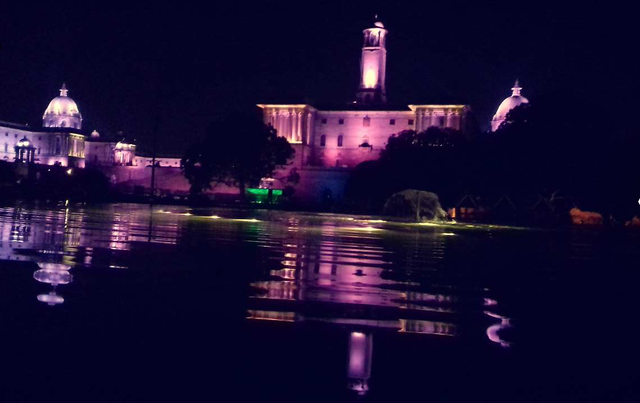
The premises of the Rashtrapati Bhavan has been divided into three circuits and can be accessed by an authorised visitor at specific times slots over the day. The first one is the Main Building and Central Lawn, where you can spectate the architecture firsthand. The second circuit is the Rashtrapati Bhawan Museum complex, which has a number of buildings within its own perimeter. The third circuit comprises of the marvellous Mughal Gardens which is a paradise of elegant gardens and lush greenery. Visit the Rashtrapati Bhavan for a marvellous acquaintance with all that is splendid and awe-inspiring.
For the convenience of the general public, Delhi Tourism has extended the facility of Ho-Ho Buses to the Rashtrapati Bhavan.
"For tourist desirous of visiting Rashtrapati Bhavan, prior online booking may be made."
For more details please visit http://rashtrapatisachivalaya.gov.in/rbtour
- Where To Stay In Delhi
There are many options on where to stay in Delhi. From luxury hotels like, The Taj Mahal Hotel, The Oberoi, Leela Palace, Le Meridian, The Lalit and Shangri La to mid-range hotels like Holiday Inn, Radisson Blu, Picadili and IBIS hotel. You also have the option of apartments in the city. Most are well located like Shangri La and Radisson that are on Connaught Street. For more on where to stay in New Delhi, we will update full list of hotels covering all budgets hotel in our future post.
Come and explore Delhi with Rainbow Explorers, India
Source
Plagiarism is the copying & pasting of others work without giving credit to the original author or artist. Plagiarized posts are considered spam.
Spam is discouraged by the community, and may result in action from the cheetah bot.
More information and tips on sharing content.
If you believe this comment is in error, please contact us in #disputes on Discord
Downvoting a post can decrease pending rewards and make it less visible. Common reasons:
Submit
Congratulations @rainbowexplorers! You have completed some achievement on Steemit and have been rewarded with new badge(s) :
Click on the badge to view your Board of Honor.
If you no longer want to receive notifications, reply to this comment with the word
STOPDo not miss the last post from @steemitboard!
Participate in the SteemitBoard World Cup Contest!
Collect World Cup badges and win free SBD
Support the Gold Sponsors of the contest: @good-karma and @lukestokes
Downvoting a post can decrease pending rewards and make it less visible. Common reasons:
Submit